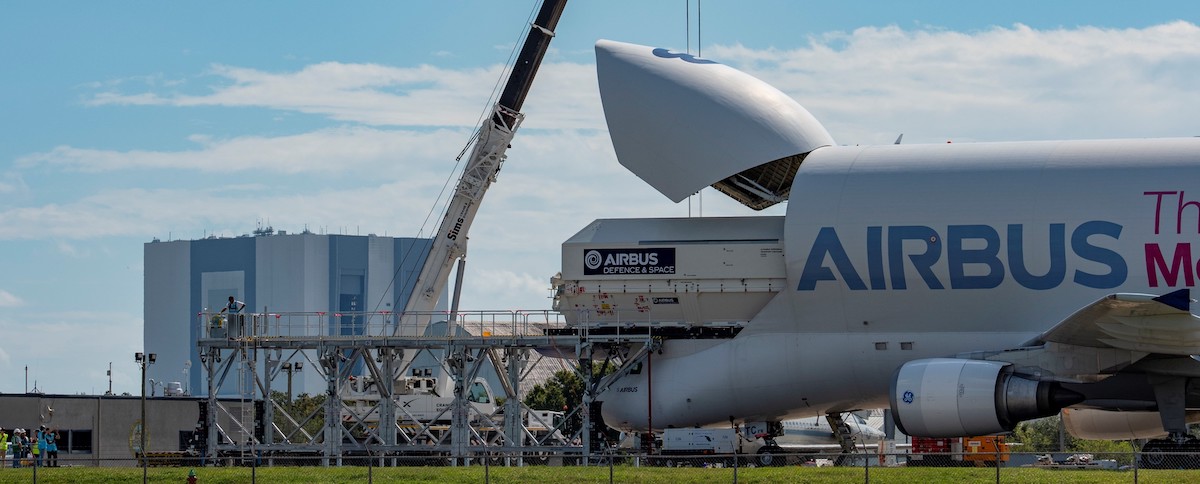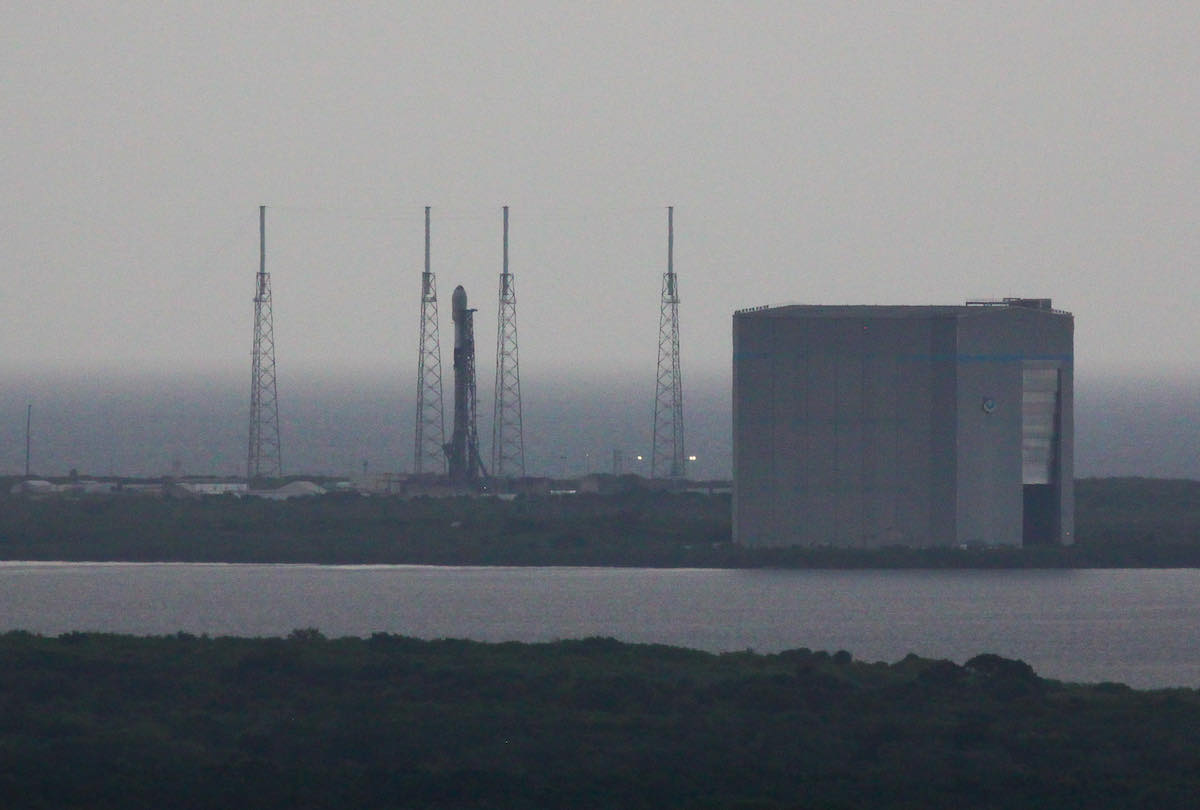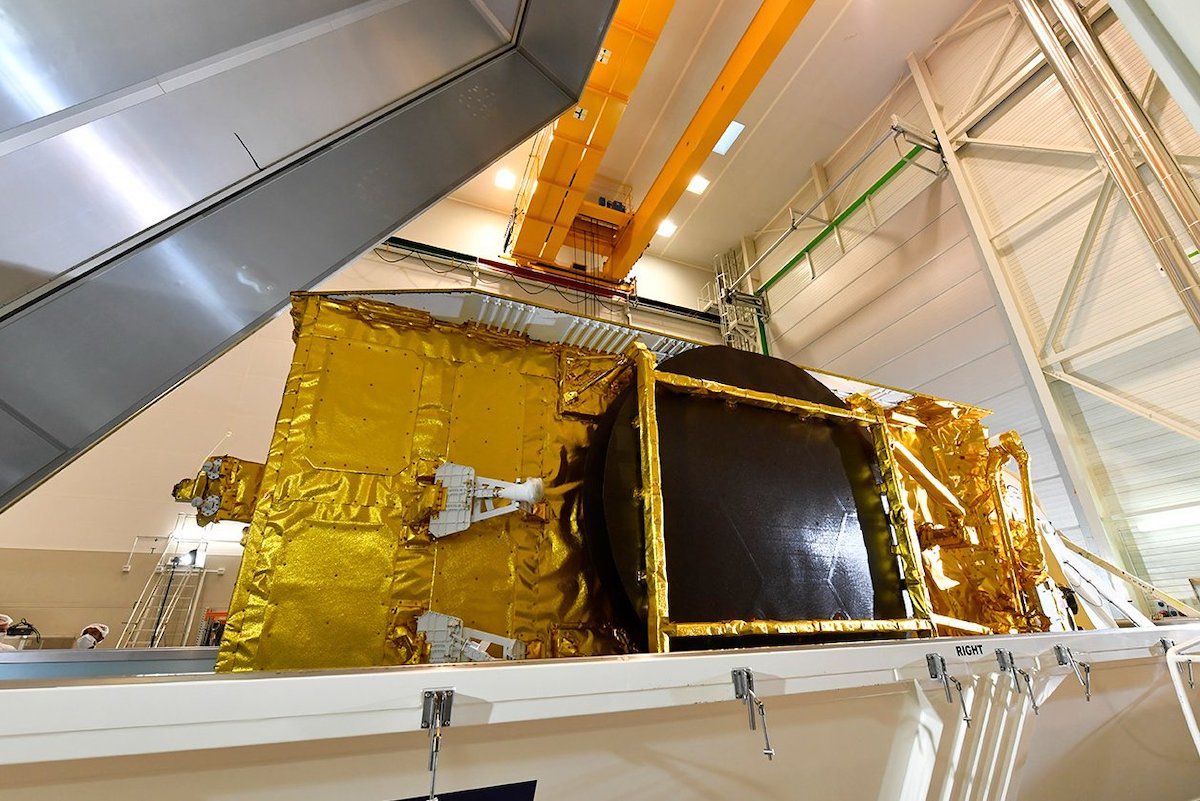
One day after launching a triple-body Falcon Heavy rocket a few miles up the coast, SpaceX rolled its workhorse Falcon 9 rocket to a launch pad at Cape Canaveral Wednesday for a late night mission to haul a Eutelsat television broadcasting satellite into orbit.
Eutelsat’s Hotbird 13G communications satellite folded up for launch on top of the Falcon 9 rocket is the twin of the Hotbird 13F spacecraft, which launched Oct. 15 on a previous SpaceX Falcon 9 mission.
Now the second of Eutelsat’s new pair of TV broadcasting satellites is ready to fly. SpaceX has a 116-minute launch window available Wednesday night beginning at 11:26 p.m. EDT (0326 GMT Thursday).
Ground teams moved the Falcon 9 rocket to pad 40 at Cape Canaveral on Wednesday, then raised it vertical in preparation for the late-night countdown. Forecasters predict a 90% chance of favorable weather for the launch window Wednesday night.
The Falcon 9 rocket will fire into space on a trajectory east from Florida’s Space Coast, targeting an elongated transfer orbit stretching more than 30,000 miles (50,000 kilometers) above Earth at its highest point. The Falcon 9’s upper stage will release the nearly 10,000-pound (4.5-metric ton) Hotbird 13G spacecraft into orbit about 36 minutes after liftoff.
The rocket’s first stage — designated B1067 — will return to landing on SpaceX’s drone ship “Just Read the Instructions” a few hundred miles downrange in the Atlantic Ocean. The reusable booster is poised for its seventh flight to space.
The launch of Hotbird 13G comes a day-and-a-half after SpaceX launched the first Falcon Heavy rocket in more than three years from pad 39A at Kennedy Space Center, a few miles north of pad 40, where the Falcon 9 is awaiting blastoff Wedneday night. The Falcon Heavy, made by combining three Falcon rocket cores together, deployed multiple U.S. Space Force payloads into a circular near-geosynchronous orbit more than 20,000 miles over the equator.
The high-altitude deployment required the Falcon Heavy’s upper stage to coast through space for more than six hours. Hotbird 13G will eventually take up a position in a similar geosynchronous orbit over the equator, but the Falcon 9 rocket Wednesday night will only do part of the lifting. The new Eutelsat communications satellite will use on-board thrusters to maneuver from its drop-off, or transfer orbit, into its final orbital position over the next few months.

Hotbird 13G is the second satellite built on the new Eurostar Neo spacecraft platform designed by Airbus Defense and Space, with funding support from the European Space Agency. The Eurostar Neo satellite design can accommodate additional payload capacity, and introduces more efficient power and thermal control systems than the previous generation of Eurostar E3000 Airbus-built satellites.
The Hotbird 13F satellite launched last month was the first to use the new Eurostar Neo spacecraft design.
“It’s a huge new product, payload centric, more competitive than anything we have ever done,” said François Gaullier, head of telecommunications satellites at Airbus, in a press conference last month.
ESA provided about 130 million euros, or $126 million at current exchange rates, to help pay for development of the new satellite platform. Airbus funded the rest of the development cost with its own money under the umbrella of a public-private partnership.
Eutelsat, a Paris-based commercial satellite operator, was the first customer to sign up for the new spacecraft design, inking a contract in 2018 for Airbus to build the Hotbird 13F and 13G on the Eurostar Neo platform.
So far, Airbus has sold eight satellites based on the new Eurostar Neo platform, including Hotbird 13F and 13G. Other customers for the Eurostar Neo satellite design include the UK Ministry of Defense, which signed a contract with Airbus to build a secure military communications satellite on the new spacecraft platform.
Airbus delivered the Hotbird 13G spacecraft from its factory in Toulouse, France, to Kennedy Space Center on Oct. 15, hours after the launch of its sister ship Hotbird 13F. One of Airbus’s large Beluga cargo airplanes, typically used to haul Airbus airplane parts between manufacturing sites in Europe, ferried the Hotbird 13G satellite from France to the United States.
It was the first time an Airbus Beluga cargo plane visited the United States since 2009, when a Beluga delivered a new module for the International Space Station to the launch site in Florida. Airbus has six new Beluga transport planes in its fleet, based on the A330 jetliner, to move the company’s own equipment across Europe. That is allowing the Airbus to transition five older-generation Belugas for other uses, such as hauling outsize cargo such as helicopters, industrial machinery, or satellites.
Russian-owned Antonov cargo planes were commonly used to carry satellites from their factories to launch sites around the world until Russian aircraft were banned from U.S. and European airspace after the military invasion of Ukraine. That forced large commercial satellite builders to switch to slower-moving ships for transportation. Some Ukrainian-owned Antonov cargo aircraft are available for satellite transport services, and military airplanes can be used for government spacecraft.
Airbus hopes the Belugas will help pick up the slack for transporting company’s own satellites ,and potentially even spacecraft from other manufacturers.

After separating from the Falcon 9 launcher to begin its journey toward geostationary orbit, Hotbird 13G unfurl solar panels and use PPS5000 plasma orbit-raising thrusters developed by the French company Safran for several months of orbit-raising maneuvers to reach a circular geostationary orbit more than 22,000 miles (nearly 36,000 kilometers) over the equator.
The fuel-efficient plasma propulsion system relies on xenon gas and electricity to generate thrust, rather than a conventional liquid rocket fuel like hydrazine. That reduces the weight of the satellite, allowing engineers to launch on a smaller rocket or add additional payloads to support more communications capacity for customers.
But the orbit-raising using electric propulsion takes longer than maneuvers relying on conventional rocket engines.
Hotbird 13G, like its predecessor Hotbird 13F, will orbit in lock-step with Earth’s rotation at 13 degrees east longitude.
By the middle of next year, Hotbird 13G should be ready to enter commercial service to start a 15-year mission broadcasting television programming to Eutelsat customers. Thanks to improvements in satellite communications technology, Eutelsat will only need two new Hotbird satellites to replace the three aging Hotbird spacecraft operating at 13 degree east.
Pascal Homsy, Eutelsat’s chief technical officer, said the Hotbird fleet at 13 degrees east form the highest capacity satellite broadcasting system covering the Europe, Middle East, and North Africa regions, delivering 1,000 TV channels to more than 160 million homes. Hotbird 13F and 13G will broadcast signals in Ku-band frequencies.
“We have something like over 600 pay TV channels, 300 free to air channels, 450 high definition TV, and 14 ultra high definition channels broadcast from this flagship 13 degrees east position,” Homsy said last month before the launch of Hotbird 13F. “We are able also to provide 500 radio stations and multimedia services.”
The launch of Hotbird 13G will mark SpaceX’s 51st mission of 2022, and the second in a series of three Falcon 9 flights for Eutelsat. The Eutelsat 10B communications satellite, designed to provide in-flight internet connectivity to airline passengers, was delivered from Europe to Cape Canaveral by boat last week for a launch on a Falcon 9 rocket later this month.
Email the author.
Follow Stephen Clark on Twitter: @StephenClark1.
